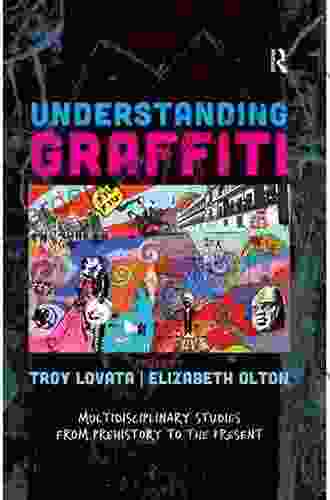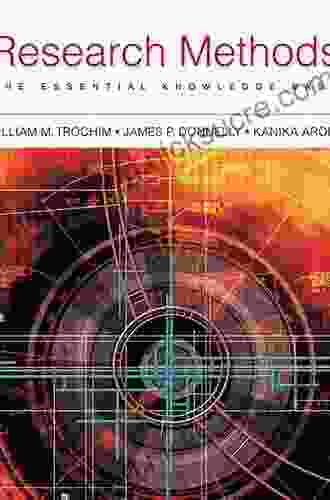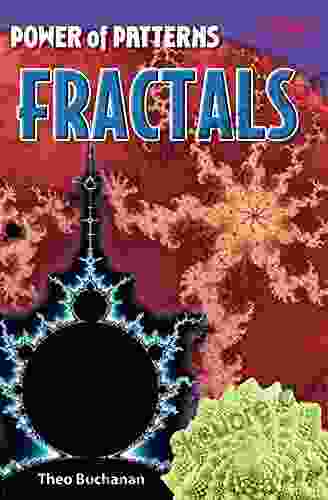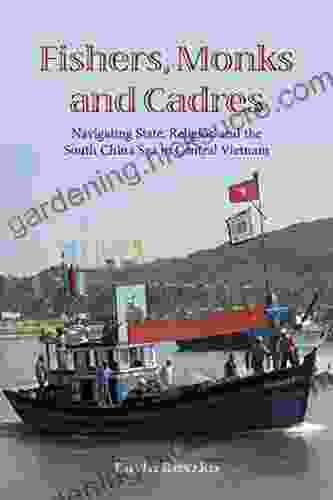Multidisciplinary Studies: Exploring Interconnections from Prehistory to the Present

The Dawn of Multidisciplinarity: Prehistoric Roots
The earliest traces of multidisciplinary thinking can be found in the iconic cave paintings of Lascaux. These prehistoric masterpieces, created around 17,000 years ago, combine elements of art, anthropology, and natural history. The intricate depictions of animals, humans, and cave formations provide valuable insights into the lives, beliefs, and environmental interactions of our ancient ancestors.
5 out of 5
| Language | : | English |
| File size | : | 9029 KB |
| Text-to-Speech | : | Enabled |
| Screen Reader | : | Supported |
| Enhanced typesetting | : | Enabled |
| Word Wise | : | Enabled |
| Print length | : | 265 pages |

These early multidisciplinary endeavors were driven by the need to understand the complex world around and the search for meaning in the human experience. By combining different perspectives, prehistoric societies gained a more comprehensive view of their surroundings and their place within it.
Ancient Civilizations: Interdisciplinary Innovations
As civilizations emerged and flourished, multidisciplinary approaches became increasingly prevalent. In ancient Egypt, scribes and priests possessed knowledge in various fields, including astronomy, mathematics, medicine, and engineering. This interdisciplinary collaboration allowed them to develop complex systems of writing, calendars, and irrigation networks.
In ancient Greece, philosophers like Aristotle embraced a holistic approach to knowledge. They explored the interconnections between physics, metaphysics, ethics, and politics, seeking to understand the fundamental nature of reality and human existence.
The Roman Empire also fostered multidisciplinarity, particularly in the realms of law, engineering, and architecture. Roman jurists developed comprehensive legal systems that influenced later legal traditions worldwide. Their engineers and architects constructed remarkable structures that combined artistic beauty with structural integrity.
Renaissance and Enlightenment: Interdisciplinary Flourishing
During the Renaissance and Enlightenment periods, multidisciplinary studies experienced a resurgence. Artists like Leonardo da Vinci excelled in multiple fields, embodying the "Renaissance Man" ideal. His notebooks reveal a vast range of interests, from anatomy and engineering to art and philosophy.
The Enlightenment emphasized reason and empiricism, leading to advancements in scientific fields. Scientists like Isaac Newton combined mathematics, physics, and astronomy to develop groundbreaking theories that revolutionized our understanding of the universe.
19th and 20th Centuries: Institutionalization of Multidisciplinarity
In the 19th and 20th centuries, the institutionalization of higher education led to the establishment of university departments dedicated to specific disciplines. However, multidisciplinary approaches continued to flourish in various forms.
In the early 20th century, the rise of interdisciplinary fields like biochemistry and biophysics reflected the growing recognition of the interconnected nature of different scientific disciplines.
During World War II, multidisciplinary teams of scientists and engineers collaborated on projects like the Manhattan Project, demonstrating the power of diverse perspectives in solving complex problems.
In the postwar era, universities began to offer interdisciplinary programs that allowed students to combine studies from different disciplines, recognizing the value of cross-disciplinary learning.
21st Century: Multidisciplinarity in the Digital Age
The 21st century has witnessed an explosion of multidisciplinary research, driven by advances in technology and globalization.
Digital tools and data analysis have enabled researchers to integrate vast amounts of information from multiple sources, leading to new insights and discoveries in fields ranging from climate science to social sciences.
The increasing interconnectedness of our world has also necessitated multidisciplinary approaches to address global challenges such as climate change, pandemics, and economic inequality.
Benefits of Multidisciplinary Studies
Multidisciplinary studies offer numerous benefits, including:
- Enhanced Understanding: By combining diverse perspectives, multidisciplinary studies provide a more comprehensive and nuanced understanding of complex issues.
- Innovation and Creativity: The cross-pollination of ideas from different disciplines fosters innovation and the development of creative solutions.
- Problem-Solving Skills: Multidisciplinary approaches equip students and researchers with the ability to analyze and solve problems from multiple perspectives.
- Intercultural Competence: By engaging with diverse fields, students develop intercultural competence and an appreciation for different ways of knowing.
- Career Flexibility: Graduates with multidisciplinary backgrounds are well-prepared for a wide range of career paths in today's interconnected world.
Challenges of Multidisciplinarity
Despite its benefits, multidisciplinary studies also face certain challenges:
- Communication Barriers: Researchers from different disciplines may use specialized jargon and concepts, making communication and collaboration challenging.
- Methodological Differences: Different disciplines have their own methodologies and research approaches, which can be difficult to reconcile in multidisciplinary projects.
- Funding and Resources: Multidisciplinary research often requires funding and resources from multiple sources, which can be challenging to secure.
Multidisciplinary studies have played a pivotal role in human understanding and progress throughout history. From the cave paintings of our ancestors to the cutting-edge scientific collaborations of today, the integration of diverse perspectives and methodologies has led to groundbreaking discoveries and innovative solutions.
As we face the challenges and opportunities of the 21st century, multidisciplinary approaches will continue to be essential for addressing complex global issues and fostering a more interconnected and sustainable world.
5 out of 5
| Language | : | English |
| File size | : | 9029 KB |
| Text-to-Speech | : | Enabled |
| Screen Reader | : | Supported |
| Enhanced typesetting | : | Enabled |
| Word Wise | : | Enabled |
| Print length | : | 265 pages |
Do you want to contribute by writing guest posts on this blog?
Please contact us and send us a resume of previous articles that you have written.
 Fiction
Fiction Non Fiction
Non Fiction Romance
Romance Mystery
Mystery Thriller
Thriller SciFi
SciFi Fantasy
Fantasy Horror
Horror Biography
Biography Selfhelp
Selfhelp Business
Business History
History Classics
Classics Poetry
Poetry Childrens
Childrens Young Adult
Young Adult Educational
Educational Cooking
Cooking Travel
Travel Lifestyle
Lifestyle Spirituality
Spirituality Health
Health Fitness
Fitness Technology
Technology Science
Science Arts
Arts Crafts
Crafts DIY
DIY Gardening
Gardening Petcare
Petcare Subsequent Edition Kindle Edition
Subsequent Edition Kindle Edition Lars Behnke
Lars Behnke Jack M Bloom
Jack M Bloom Mei Fong
Mei Fong William Regal
William Regal David Beaupre
David Beaupre Syougo Kinugasa
Syougo Kinugasa Bree Moore
Bree Moore Pat Dorsey
Pat Dorsey Chris Stewart
Chris Stewart Dan Blackburn
Dan Blackburn Claire Baker
Claire Baker Raymond Buckland
Raymond Buckland Carol Stock Kranowitz
Carol Stock Kranowitz 8th Edition Kindle Edition
8th Edition Kindle Edition Emily A Duncan
Emily A Duncan Brennan Barnard
Brennan Barnard Stefan Hofer
Stefan Hofer Robert Venditti
Robert Venditti Donna M Mertens
Donna M Mertens 006 Edition Kindle Edition
006 Edition Kindle Edition Monte Burch
Monte Burch Michael Geheran
Michael Geheran Heather Rain Mazen Korbmacher
Heather Rain Mazen Korbmacher Mimi Lemay
Mimi Lemay Emma Dalton
Emma Dalton John Collins
John Collins Joseph Chilton Pearce
Joseph Chilton Pearce Collins Gcse
Collins Gcse Robert S Mueller
Robert S Mueller Elaine Beaumont
Elaine Beaumont Bruno Latour
Bruno Latour 1st Edition Kindle Edition
1st Edition Kindle Edition Neal Bascomb
Neal Bascomb Daphne Adler
Daphne Adler Bryan Smith
Bryan Smith Sloane Mcclain
Sloane Mcclain Kristi K Hoffman
Kristi K Hoffman Lewis Henry Morgan
Lewis Henry Morgan Robert Ferguson
Robert Ferguson Pamela Adams
Pamela Adams Shonna Slayton
Shonna Slayton Bertolt Brecht
Bertolt Brecht Kyla Stone
Kyla Stone Paul Martin
Paul Martin Gregory J Privitera
Gregory J Privitera Don Fink
Don Fink Gayle Jervis
Gayle Jervis Deanne Howell
Deanne Howell Tami Lynn Kent
Tami Lynn Kent Tim R Wolf
Tim R Wolf Claire Sierra
Claire Sierra Terence N D Altroy
Terence N D Altroy Suzie Cooney
Suzie Cooney 7th Edition Kindle Edition
7th Edition Kindle Edition Rifujin Na Magonote
Rifujin Na Magonote Temple Grandin
Temple Grandin Mike Tyson
Mike Tyson Claudio De Castro
Claudio De Castro Chase Williams
Chase Williams P G Maxwell Stuart
P G Maxwell Stuart Natalie Smith
Natalie Smith Laurie Forest
Laurie Forest Josh Mulvihill
Josh Mulvihill Rick Gurnsey
Rick Gurnsey John Iceland
John Iceland Bookrags Com
Bookrags Com Jong Chul Ye
Jong Chul Ye Nancy Keene
Nancy Keene Kenny Casanova
Kenny Casanova Lareina Rule
Lareina Rule Sandra Mizumoto Posey
Sandra Mizumoto Posey Lj Rivers
Lj Rivers Aly Madhavji
Aly Madhavji Gershon Ben Keren
Gershon Ben Keren G I Gurdjieff
G I Gurdjieff Naomi Feil
Naomi Feil Charles Seife
Charles Seife Michael Alvear
Michael Alvear Dervla Murphy
Dervla Murphy Heather Demetrios
Heather Demetrios Jonathan Ross
Jonathan Ross Gregory A Boyd
Gregory A Boyd Dominik Hartmann
Dominik Hartmann Lenora Ucko
Lenora Ucko Steve Garnett
Steve Garnett Steve Magness
Steve Magness E Bruce Goldstein
E Bruce Goldstein Melissa Cheyney
Melissa Cheyney Michael W Ford
Michael W Ford Louis Stanislaw
Louis Stanislaw 2nd Edition Kindle Edition
2nd Edition Kindle Edition Mitch Rubman
Mitch Rubman Mark V Wiley
Mark V Wiley Patricia S Potter Efron
Patricia S Potter Efron Gina Rae La Cerva
Gina Rae La Cerva Alessa Ellefson
Alessa Ellefson Peter Wohlleben
Peter Wohlleben Lois Duncan
Lois Duncan Chris I Naylor
Chris I Naylor Manhattan Prep
Manhattan Prep 2012th Edition Kindle Edition
2012th Edition Kindle Edition Edward Rosenfeld
Edward Rosenfeld Elizabeth D Hutchison
Elizabeth D Hutchison Alec Crawford
Alec Crawford Olszewski Marie Erin
Olszewski Marie Erin Theresa Cheung
Theresa Cheung Bill Reif
Bill Reif Jasper Godwin Ridley
Jasper Godwin Ridley Tom Lyons
Tom Lyons Jamaica Stevens
Jamaica Stevens Tony Hernandez Pumarejo
Tony Hernandez Pumarejo Bruce Watson
Bruce Watson Prerna Lal
Prerna Lal Michael S Gazzaniga
Michael S Gazzaniga Edyta Roszko
Edyta Roszko Diane Duane
Diane Duane Jo Frost
Jo Frost George W E Nickelsburg
George W E Nickelsburg Joseph E Garland
Joseph E Garland Richard Bromfield
Richard Bromfield John Kreiter
John Kreiter Billie Jean King
Billie Jean King A C Grayling
A C Grayling Icon Digital Publishing
Icon Digital Publishing Michael Clarke
Michael Clarke Karen Myers
Karen Myers Skye Genaro
Skye Genaro Frank Sargeant
Frank Sargeant Dr Brenda Stratton
Dr Brenda Stratton Carl J Sindermann
Carl J Sindermann Elizabeth Sims
Elizabeth Sims Duy Tran
Duy Tran Dustyn Roberts
Dustyn Roberts Kekla Magoon
Kekla Magoon James Diego Vigil
James Diego Vigil L S Boos
L S Boos Leslie Leyland Fields
Leslie Leyland Fields Hong Chen
Hong Chen David Lloyd Kilmer
David Lloyd Kilmer Nathalie Dupree
Nathalie Dupree Peter Cossins
Peter Cossins Elizabeth Wenk
Elizabeth Wenk Nate G Hilger
Nate G Hilger Monica Sorrenson
Monica Sorrenson Karl Morris
Karl Morris Terrence Real
Terrence Real Miranda Castro
Miranda Castro Eloise Jarvis Mcgraw
Eloise Jarvis Mcgraw Robert Bauval
Robert Bauval Andrew Shapland
Andrew Shapland Andy Charalambous
Andy Charalambous Elizabeth Bradfield
Elizabeth Bradfield Marie Louise Von Franz
Marie Louise Von Franz 3rd Edition Kindle Edition
3rd Edition Kindle Edition 4th Edition Kindle Edition
4th Edition Kindle Edition Dalai Lama
Dalai Lama Porter Fox
Porter Fox Alan Jacobs
Alan Jacobs Laura Bright
Laura Bright James Mcnicholas
James Mcnicholas David Kushner
David Kushner Geri Ann Galanti
Geri Ann Galanti Freda Mcmanus
Freda Mcmanus Robert Peter Gale
Robert Peter Gale Patrick Hunt
Patrick Hunt Paul Johnson
Paul Johnson Justine Brooks Froelker
Justine Brooks Froelker Gail Craswell
Gail Craswell Edward Frenkel
Edward Frenkel Thomas R Baechle
Thomas R Baechle Grant Thompson
Grant Thompson Sherry Monahan
Sherry Monahan Justin Hammond
Justin Hammond Keith Siragusa
Keith Siragusa Jd Brown
Jd Brown Jon Dunn
Jon Dunn Meik Wiking
Meik Wiking Jillian Dodd
Jillian Dodd 3rd Ed Edition Kindle Edition
3rd Ed Edition Kindle Edition Evan Brashier
Evan Brashier Brenda Dehaan
Brenda Dehaan Dan Wingreen
Dan Wingreen Marcia Verduin
Marcia Verduin 1st Ed 2016 Edition Kindle Edition
1st Ed 2016 Edition Kindle Edition Nathan Jendrick
Nathan Jendrick Naomi Scott
Naomi Scott Vibrant Publishers
Vibrant Publishers John Coleman
John Coleman Tracy Gharbo
Tracy Gharbo Nadav Snir
Nadav Snir Bobby Blair
Bobby Blair Mauricio Cabrini
Mauricio Cabrini John Green
John Green Max Domi
Max Domi Nikki Grimes
Nikki Grimes Herbert Feigl
Herbert Feigl Andrew Collins
Andrew Collins Brooklyn James
Brooklyn James Filipe Masetti Leite
Filipe Masetti Leite Stephen P Anderson
Stephen P Anderson Justin Bower
Justin Bower A Christine Harris
A Christine Harris L Ulloque
L Ulloque Steven D Levitt
Steven D Levitt Robert A Johnson
Robert A Johnson Brian Thompson
Brian Thompson Nick Winkelman
Nick Winkelman John Hands
John Hands Andrew Maraniss
Andrew Maraniss Joe Chilson
Joe Chilson Christopher Mcdougall
Christopher Mcdougall Nnedi Okorafor
Nnedi Okorafor Leon Anderson
Leon Anderson Manuel De La Cruz
Manuel De La Cruz Jim Burns
Jim Burns Muata Ashby
Muata Ashby Roselyn Teukolsky
Roselyn Teukolsky Broccoli Lion
Broccoli Lion Allan Mundsack
Allan Mundsack Cassandra Johnson
Cassandra Johnson Ernest Shackleton
Ernest Shackleton Jessica Shortall
Jessica Shortall Greg Midland
Greg Midland Diamond Wilson
Diamond Wilson Terence Grieder
Terence Grieder Clint Malarchuk
Clint Malarchuk J D Salinger
J D Salinger Gianni La Forza
Gianni La Forza Jamie Hand
Jamie Hand Jay Cassell
Jay Cassell Leonardo Trasande
Leonardo Trasande David Simkins
David Simkins Caroline Porter Thomas
Caroline Porter Thomas Robert K Tyson
Robert K Tyson Riddleland
Riddleland Richard Adams
Richard Adams James D Long
James D Long John Gookin
John Gookin Chris Dietzel
Chris Dietzel Aubrey Clayton
Aubrey Clayton Sheryl Crow
Sheryl Crow Chris Froome
Chris Froome Katie M John
Katie M John Sam Goulden
Sam Goulden Marisha Pessl
Marisha Pessl John Gribbin
John Gribbin Jiichi Watanabe
Jiichi Watanabe Mark Gregston
Mark Gregston Christoph Delp
Christoph Delp Patricia O Quinn
Patricia O Quinn Eric Haseltine
Eric Haseltine Tom Pyszczynski
Tom Pyszczynski Kevin Paul
Kevin Paul Josh Elster
Josh Elster Kelly Skeen
Kelly Skeen Adam Silvera
Adam Silvera Rowan Ricardo Phillips
Rowan Ricardo Phillips Dr Katayune Kaeni
Dr Katayune Kaeni 6th Edition Kindle Edition
6th Edition Kindle Edition Jozef Nauta
Jozef Nauta Margaret Littman
Margaret Littman Debra Barnes
Debra Barnes Dan Falk
Dan Falk Seymour Simon
Seymour Simon Jason Miller
Jason Miller Garrett Grolemund
Garrett Grolemund Justin Doyle
Justin Doyle Kristine Setting Clark
Kristine Setting Clark Richard Ania
Richard Ania Chris Lehto
Chris Lehto Peter Dewhurst
Peter Dewhurst Theodore X O Connell
Theodore X O Connell David Cheng
David Cheng Al Ford
Al Ford Robert Pondiscio
Robert Pondiscio Kerry Fraser
Kerry Fraser 50minutes Com
50minutes Com Mary H K Choi
Mary H K Choi Liesbet Collaert
Liesbet Collaert Thomas Wentworth Higginson
Thomas Wentworth Higginson Leigh Calvez
Leigh Calvez Micah Goodman
Micah Goodman Ben Egginton
Ben Egginton Breanna Lam
Breanna Lam Miko Flohr
Miko Flohr Andrea Wulf
Andrea Wulf Starley Talbott
Starley Talbott Howard Mudd
Howard Mudd Michael Romano
Michael Romano Barbara Klein
Barbara Klein Iris Bohnet
Iris Bohnet Amy Chua
Amy Chua Oliver Theobald
Oliver Theobald Yan Shen
Yan Shen Robert Mcentarffer
Robert Mcentarffer Kristen Riecke
Kristen Riecke Paul Deepan
Paul Deepan Linda A Roussel
Linda A Roussel Cynthia Bourgeault
Cynthia Bourgeault Robert Thurston
Robert Thurston Christa Orecchio
Christa Orecchio Oscar Wegner
Oscar Wegner Stewart Smith
Stewart Smith Jeffrey A Greene
Jeffrey A Greene Tok Hui Yeap Rd Csp Ld
Tok Hui Yeap Rd Csp Ld Sadie Radinsky
Sadie Radinsky Joe Cuhaj
Joe Cuhaj Lesli Richards
Lesli Richards John A Yoegel
John A Yoegel Brian Kent
Brian Kent Amy Ogle
Amy Ogle George Pendle
George Pendle William A Dembski
William A Dembski Jeff Gill
Jeff Gill Martha Menchaca
Martha Menchaca Leonard Pellman
Leonard Pellman Martin Mobraten
Martin Mobraten Tom Mchale
Tom Mchale Mark Brazil
Mark Brazil Eli Boschetto
Eli Boschetto 50minutos Es
50minutos Es Whit Honea
Whit Honea Shelby Hailstone Law
Shelby Hailstone Law Jay Wilkinson
Jay Wilkinson Erika Bornman
Erika Bornman Lee Smolin
Lee Smolin Barnett Rich
Barnett Rich Betty Crocker
Betty Crocker Harry Middleton
Harry Middleton Russell Miller
Russell Miller Theris A Touhy
Theris A Touhy Kate Usher
Kate Usher Jacqueeia Ferguson
Jacqueeia Ferguson Janetti Marotta
Janetti Marotta Jasmine Greene
Jasmine Greene Alice Ginott
Alice Ginott 5th Edition Kindle Edition
5th Edition Kindle Edition Andrew G Marshall
Andrew G Marshall Dinokids Press
Dinokids Press Heather Job
Heather Job Louis Liebenberg
Louis Liebenberg Ulla Sarmiento
Ulla Sarmiento Roger Gordon
Roger Gordon Apsley Cherry Garrard
Apsley Cherry Garrard Kennedy Achille
Kennedy Achille Patrick Viafore
Patrick Viafore Dave Gerr
Dave Gerr Sarah Templeton
Sarah Templeton Sam Irwin
Sam Irwin Buddy Martin
Buddy Martin Samantha Lovely
Samantha Lovely Wong Kiew Kit
Wong Kiew Kit Mark Hatmaker
Mark Hatmaker Eric Dominy
Eric Dominy Eric I Karchmer
Eric I Karchmer L Madison
L Madison Mohamed Elgendy
Mohamed Elgendy Tony Horton
Tony Horton Jenifer Fox
Jenifer Fox Gregory Collins
Gregory Collins Ellen Levitt
Ellen Levitt J Morgan Mcgrady
J Morgan Mcgrady Dr Danny Penman
Dr Danny Penman Debra Pascali Bonaro
Debra Pascali Bonaro Katie J Trent
Katie J Trent Juno Dawson
Juno Dawson 4th Edition Kindle Edition With Audio Video
4th Edition Kindle Edition With Audio Video Steve Kantner
Steve Kantner Jacquetta Hawkes
Jacquetta Hawkes A C Davison
A C Davison Marty Bartholomew
Marty Bartholomew Greta Solomon
Greta Solomon A R Bernard
A R Bernard Janet Sasson Edgette
Janet Sasson Edgette Ricki E Kantrowitz
Ricki E Kantrowitz Patricia Moore Pastides
Patricia Moore Pastides Tasha Dunn
Tasha Dunn Susan E Cayleff
Susan E Cayleff Lucas Whitecotton
Lucas Whitecotton Gary S Thorpe
Gary S Thorpe Maureen Johnson
Maureen Johnson Ziemowit Wojciechowski
Ziemowit Wojciechowski 1st English Ed Edition Kindle Edition
1st English Ed Edition Kindle Edition Natasha Preston
Natasha Preston Jeremy Desilva
Jeremy Desilva Bob Welch
Bob Welch Christopher Lakeman
Christopher Lakeman Kate Spencer
Kate Spencer Susan Walker
Susan Walker Bernard Cornwell
Bernard Cornwell Jordan Ifueko
Jordan Ifueko Ellen Sue Turner
Ellen Sue Turner Bonnie Scott
Bonnie Scott A Digger Stolz
A Digger Stolz Joe Oliver
Joe Oliver Tyler Vanderweele
Tyler Vanderweele Emma Lord
Emma Lord Anthony Arvanitakis
Anthony Arvanitakis Alden Jones
Alden Jones Kelly Slater
Kelly Slater Fata Ariu Levi
Fata Ariu Levi Geoffrey West
Geoffrey West Christy Jordan
Christy Jordan Andrew Weber
Andrew Weber Eva Feder Kittay
Eva Feder Kittay Glenn N Levine
Glenn N Levine Deepak Chopra
Deepak Chopra Raymond H Thompson
Raymond H Thompson Jason Curtis
Jason Curtis J Michael Leger
J Michael Leger Patrick Lange
Patrick Lange Cindy Kennedy
Cindy Kennedy Z Justin Ren
Z Justin Ren Lin Pardey
Lin Pardey Patricia Stevens
Patricia Stevens Theodor W Adorno
Theodor W Adorno 2005th Edition Kindle Edition
2005th Edition Kindle Edition Kerri Maniscalco
Kerri Maniscalco Simon G Thompson
Simon G Thompson Michaela Stith
Michaela Stith Andre Norton
Andre Norton Jean Clottes
Jean Clottes Patrick E Mcgovern
Patrick E Mcgovern Bernard Rosner
Bernard Rosner Rashad Jennings
Rashad Jennings
Light bulbAdvertise smarter! Our strategic ad space ensures maximum exposure. Reserve your spot today!

 Milan KunderaThat Time I Got Reincarnated As A Slime: A Comprehensive Exploration of the...
Milan KunderaThat Time I Got Reincarnated As A Slime: A Comprehensive Exploration of the... George HayesFollow ·4.5k
George HayesFollow ·4.5k Fernando PessoaFollow ·2.7k
Fernando PessoaFollow ·2.7k Dylan HayesFollow ·19.5k
Dylan HayesFollow ·19.5k Robert ReedFollow ·18.8k
Robert ReedFollow ·18.8k George MartinFollow ·2.3k
George MartinFollow ·2.3k Charlie ScottFollow ·5.9k
Charlie ScottFollow ·5.9k Brady MitchellFollow ·18.3k
Brady MitchellFollow ·18.3k Billy PetersonFollow ·14k
Billy PetersonFollow ·14k

 Finn Cox
Finn CoxA Comprehensive Guide for Budding Inventors and Backyard...
For those with a restless mind and a...

 Forrest Reed
Forrest ReedThe Ultimate Shopper's Guide to Purchasing Weight Lifting...
Are you looking...

 Dillon Hayes
Dillon HayesThe Chemical Choir: Unveiling the Enchanting Symphony of...
In the enigmatic realm of science, where...

 Ryūnosuke Akutagawa
Ryūnosuke AkutagawaStumbling Thru: Hike Your Own Hike
In the realm of outdoor adventures,...
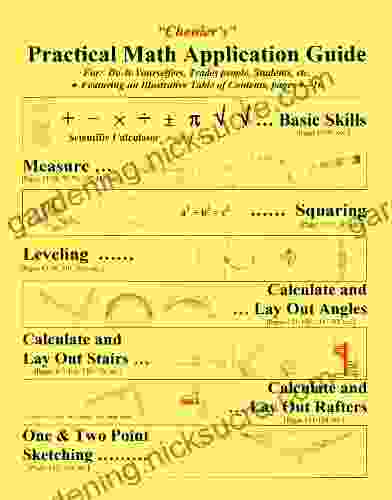
 Terry Pratchett
Terry PratchettUnlock Your Math Skills: A Comprehensive Guide to Chenier...
Math plays a vital role in...
5 out of 5
| Language | : | English |
| File size | : | 9029 KB |
| Text-to-Speech | : | Enabled |
| Screen Reader | : | Supported |
| Enhanced typesetting | : | Enabled |
| Word Wise | : | Enabled |
| Print length | : | 265 pages |


